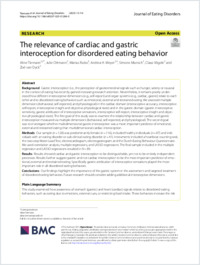The relevance of cardiac and gastric interoception for disordered eating behavior
PSPE
- Tiemann, Aline ORCID Department of Clinical Psychology and Psychotherapy, University of Fribourg, Switzerland. Institute for Health and Behaviour, University of Luxembourg
- Ortmann, Julie ORCID Institute for Health and Behaviour, University of Luxembourg
- Rubo, Marius ORCID Institute of Psychology, University of Bern
- Meyer, Andrea H. Department of Clinical Psychology and Psychotherapy, University of Fribourg, Switzerland. Department of Psychology, University of Basel
- Munsch, Simone ORCID Department of Clinical Psychology and Psychotherapy, University of Fribourg, Switzerland
- Vögele, Claus ORCID Institute for Health and Behaviour, University of Luxembourg
- van Dyck, Zoé ORCID Institute for Health and Behaviour, University of Luxembourg
- 2025
Published in:
- Journal of Eating Disorders. - Springer Science and Business Media LLC. - 2025, vol. 13, p. 1-17
Interoception
Cardiac interoception
Gastric interoception
Multidimensional
Disordered eating behavior
Emotional eating
External eating
Restrained eating
Machine learning
English
Background: Gastric interoception (i.e., the perception of gastrointestinal signals such as hunger, satiety or nausea) in the context of eating has recently gained increasing research attention. Nevertheless, it remains poorly understood how different interoceptive dimensions (e.g., self-report) and organ systems (e.g., cardiac, gastric) relate to each other and to disordered eating behaviors such as emotional, external and restrained eating. We assessed multiple dimensions (behavioral, self-reported, and physiological) in the cardiac domain (interoceptive accuracy, interoceptive self-report, interoceptive insight and objective physiological state) and in the gastric domain (gastric interoceptive sensitivity, gastric attribution of interoceptive sensations, interoceptive self-report, interoceptive insight and objective physiological state). The first goal of this study was to examine the relationship between cardiac and gastric interoception measured via multiple dimensions (behavioral, self-reported, and physiological). The second goal was to investigate whether multidimensional gastric interoception was a more important predictor of emotional, external and restrained eating than multidimensional cardiac interoception.
Methods: Our sample (n = 128) was predominantly female (n = 116), included healthy individuals (n = 87) and individuals with an eating disorder or sub-clinical eating disorder (n = 41). Instruments included a heartbeat counting task, the two-step Water Load Test, electrocardiogram, electrogastrogram and the Dutch-Eating Behaviour Questionnaire. We used correlation analysis, multiple regressions, and LASSO regressions. The final sample included in the multiple regression and LASSO regressions resulted in N = 89.
Results : Results showed cardiac and gastric interoception to be distinguishable, yet not to be entirely independent processes. Results further suggest gastric and not cardiac interoception to be the most important predictor of emotional, external and restrained eating. Specifically gastric attribution of interoceptive sensations played the most important role in all disordered eating behaviors.
Conclusions : Our findings highlight the importance of the gastric system in the assessment and targeted treatment of disordered eating behaviors. Future research should consider adding additional interoceptive dimensions.
Methods: Our sample (n = 128) was predominantly female (n = 116), included healthy individuals (n = 87) and individuals with an eating disorder or sub-clinical eating disorder (n = 41). Instruments included a heartbeat counting task, the two-step Water Load Test, electrocardiogram, electrogastrogram and the Dutch-Eating Behaviour Questionnaire. We used correlation analysis, multiple regressions, and LASSO regressions. The final sample included in the multiple regression and LASSO regressions resulted in N = 89.
Results : Results showed cardiac and gastric interoception to be distinguishable, yet not to be entirely independent processes. Results further suggest gastric and not cardiac interoception to be the most important predictor of emotional, external and restrained eating. Specifically gastric attribution of interoceptive sensations played the most important role in all disordered eating behaviors.
Conclusions : Our findings highlight the importance of the gastric system in the assessment and targeted treatment of disordered eating behaviors. Future research should consider adding additional interoceptive dimensions.
- Faculty
- Faculté des lettres et des sciences humaines
- Department
- Département de Psychologie
- Language
-
- English
- Classification
- Psychology
- License
- Open access status
- gold
- Identifiers
-
- DOI 10.1186/s40337-025-01284-0
- ISSN 2050-2974
- Persistent URL
- https://folia.unifr.ch/unifr/documents/332371
Statistics
Document views: 40
File downloads:
- s40337-025-01284-01: 21
